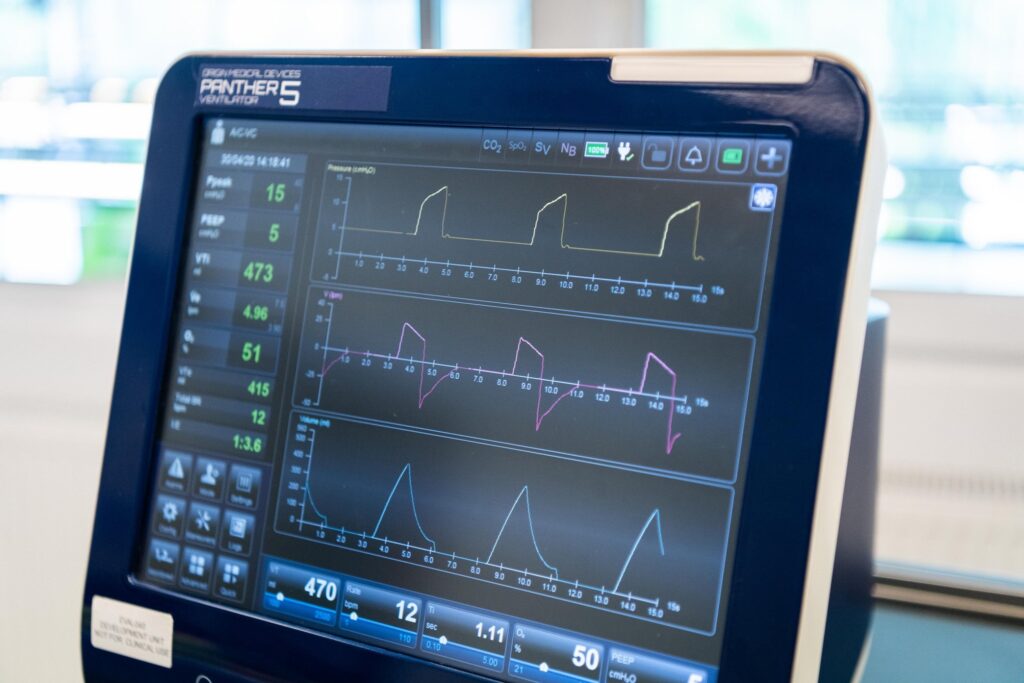The https://english.atlatszo.hu use cookies to track and profile customers such as action tags and pixel tracking on our website to assist our marketing. On our website we use technical, analytical, marketing and preference cookies. These are necessary for our site to work properly and to give us inforamation about how our site is used. See Cookies Policy
Domestic ventilator business started producing while 15,000 Chinese machines were already gathering dust
During the COVID-19 pandemic, the Ministry of Foreign Affairs bought 1,000 ventilators from Celitron – a Dutch Israeli company based in Vác – while hundreds of billions of forints worth of Chinese equipment gathered dust in warehouses.
Péter Szijjártó and Bence Rétvári had cause to celebrate. After all, they had enthusiastically lobbied for the Hungarian production of ventilators through the autumn of 2020, and finally, the Ministry of Foreign Affairs bought 1,000 machines from the Vác-based Dutch Israeli company Celitron. By 2021, 484 Celitron machines had been delivered to hospitals across Hungary, in addition to Jordan and Bosnia-Herzegovina.

In September, pro-government news site Origo cited Szijjártó in their announcement: “The world-class ventilators made in Hungary are ready.” The paper wrote, “the Hungarian-made ventilator is the best in the world market today from a technological point of view: it can be used without age limits, has low energy consumption and can be independent of the compressed air outlets available in intensive care units in hospitals.”
Hungary was saved, Szijjártó was right, and Celitron made billions in profit in 2020. Until 2021, that is – when the company reported a loss and the coveted ventilator disappeared from its website without a trace.
The decision to buy ventilators…
Hungarian manufacturer Celitron primarily focuses on R&D surrounding sterilization and waste management systems. The company was chosen to manufacture the ventilators – which was particularly peculiar, because the company did not manufacture ventilators.
Ádám Péter, a medical lieutenant colonel at the Hungarian Defence Medical Centre, explained that the government turned to Celitron because they were unable to procure ventilators from abroad.
“It was impossible to import from known, tried and tested, high-quality European suppliers, partly due to export bans and partly due to lack of capacity. The countries of the world turned to the Chinese state, which had huge reserves, but the quality of ventilators available on the Chinese market was variable,” he said.
Celitron was able to acquire all the necessary manufacturing equipment quickly through economic diplomacy, and the government provided logistical support to accelerate the manufacturing process. The company produced the first hundred units of professional, state-of-the-art ventilators by early July 2020, and the first thousand by August 2020.
The instructions manual for the ventilators was uploaded to the Hungarian Society of Anaesthesiology and Intensive Care website – but has since been deleted.
…when we already had ventilators at home
The Ministry of Foreign Affairs and Trade (MFA) revealed that the delivery of the Celitron Panther 5 ventilators started after the press conference on 25 September 2020. The first thousand ventilators were delivered in four waves of 250. According to the MFA’s information, they cost 29,000 euros plus VAT, which would have amounted to 10.4 million HUF per machine. The 1,000 machines cost 10.4 billion HUF in total.
Money well spent – ventilators, after all, were life-saving equipment during the pandemic.
Except, Hungary already had 15,825 machines stored away,
as reported by Direkt36. The average price of the ventilators purchased from abroad was 57,106 euros (20.1 million HUF at current exchange rates), culminating in a total cost of more than 300 billion HUF.
Indeed, of the 16,000 Chinese-manufactured ventilators that the government ordered in the pandemic’s first wave, around 13,000 sat in storage, around one hundred were sent abroad, and 3,288 were sent to Hungarian hospitals.
The storage of nearly 14,000 machines since October 2020 cost close to 400 million HUF. The Hungarian foreign ministry also bought 1,000 Chinese ventilators from Fourcardinal Consulting Ltd for more than 17 billion forints, which generated a profit of 20 billion forints in two years for the company – a great success that was followed immediately by the company’s liquidation.
It’s a common conundrum: a child will ask for McDonald’s, only for a parent to tell them they have food at home. The Hungarian government did not have the same sense – they ordered one thousand Celitron ventilators, of which 837 were delivered to Hungarian hospitals and 163 were put in storage.
The Hungarian state spent three hundred billion HUF on these assets during the coronavirus epidemic.

“A transport plane has brought 2,600,000 masks, 10,000 complete protective suits and 21 ventilators to Budapest via the China-Hungary air bridge, this time from the city of Tianjin.” Source: Facebook/ Péter Szijjártó
So much equipment, so little expertise
The Hungarian government was unfortunately unable to buy know-how when it went on its uncontrolled ventilator shopping spree in August 2020.
Béla Merkely, the rector of Semmelweis University, warned that the Hungarian hospital network’s capacity for intensive care was limited to 1,000 patients on ventilators, with around 800 to 1,200 beds – that’s how many patients can be resuscitated with the existing number of specialists.
Patients that exceed the 1,200-capacity may be on ventilators – but it’s likely the last place they will be.
Anaesthesiologist and intensive care specialist András Lovas wrote, “Ventilators alone are not worth much, if there are not enough well-trained staff – it doesn’t matter how many thousands of them there are.”
Billions on commission
Celitron produced mainly for export, according to the company’s financial statements, with mixed success. Between 2015 and 2019, they generated a revenue of 7.2 billion HUF and a negative operating result of one billion HUF.
The 2020 government deal brought the company 10 billion HUF in domestic revenue, with a profit of HUF 2.9 billion.
The Israeli owner did not charge a commission, and a significant part of the revenue went to an intermediary. The distributor’s commission was 23.7 million HUF in 2018 and 42 million HUF in 2019. After the ventilator deal, this rose to 1.499 billion HUF, with another 804 million HUF earmarked for 2022.
By 2021, the company was operating at a loss of 348 million HUF once again. The issue alerted NAV, who question businesses that operate with persistent losses. It is, after all, the fundamental aim of a company to make a profit.
Because the company’s website has no information about the ventilators, we asked Celitron the following:
- How many Panther 5s have been produced in addition to the government’s order;
- Where we can find a description of the machines;
- What the demand was for the products;
- On what basis did they decide to produce the machines in 2020;
- The current cost of ordering the machine, the available support, and the conditions.
Secrecy around Chinese machines
While Celitron’s business strategy remains a head-scratcher, Transparency International has filed a lawsuit to investigate how many of the 300 billion HUF-worth Chinese ventilators the Hungarian government was able to sell. They won the lawsuit, but the Ministry of the Interior appealed to the Curia, which has delayed any response.
The Ministry of Interior, led by Péter Szijjártó, also rushed to the Curia after a final court ruling in September ordered them to release documents related to the purchase of the ventilators.
Translated by Vanda Mayer. The original, Hungarian version of this story was written by Csaba Segesvári and can be found here.

